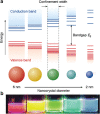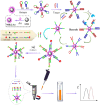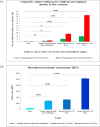Quantum Dots for Cancer-Related miRNA Monitoring
- PMID: 35486955
- PMCID: PMC9776878
- DOI: 10.1021/acssensors.2c00149
Quantum Dots for Cancer-Related miRNA Monitoring
Abstract
Quantum dots (QDs) possess exceptional optoelectronic properties that enable their use in the most diverse applications, namely, in the medical field. The prevalence of cancer has increased and has been considered the major cause of death worldwide. Thus, there has been a great demand for new methodologies for diagnosing and monitoring cancer in cells to provide an earlier prognosis of the disease and contribute to the effectiveness of treatment. Several molecules in the human body can be considered relevant as cancer markers. Studies published over recent years have revealed that micro ribonucleic acids (miRNAs) play a crucial role in this pathology, since they are responsible for some physiological processes of the cell cycle and, most important, they are overexpressed in cancer cells. Thus, the analytical sensing of miRNA has gained importance to provide monitoring during cancer treatment, allowing the evaluation of the disease's evolution. Recent methodologies based on nanochemistry use fluorescent quantum dots for sensing of the miRNA. Combining the unique characteristics of QDs, namely, their fluorescence capacity, and the fact that miRNA presents an aberrant expression in cancer cells, the researchers created diverse strategies for miRNA monitoring. This review aims to present an overview of the recent use of QDs as biosensors in miRNA detection, also highlighting some tutorial descriptions of the synthesis methods of QDs, possible surface modification, and functionalization approaches.
Keywords: bioconjugation; bioimaging; biosensor; cancer; detection; functionalization; miRNA; monitoring; quantum dots.
Conflict of interest statement
The authors declare no competing financial interest.
Figures















References
-
- World Health Organization . Cancer; https://www.who.int/news-room/fact-sheets/detail/cancer (accessed 2021-08-02).
Publication types
MeSH terms
Substances
LinkOut - more resources
Full Text Sources
Medical

